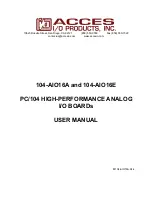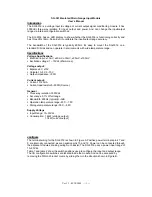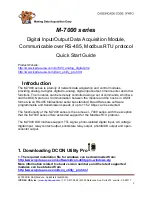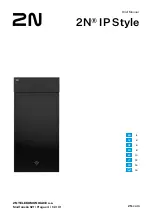
Manual 104-AIO16A and 104-AIO16E
7
Table 1-1:
Analog Input Range Selection
Jumpers SoftwareGain=0
SoftwareGain=1 SoftwareGain=2 SoftwareGain=3
Unipolar
0 - 10V
0 - 5V
0 - 2V
0 - 1V
GNH
Bipolar
± 5V
± 2.5V
± 1V
± 0.5
GNL
Bipolar
± 10V
± 5V
± 2V
± 1V
A/D Start
This board offers three software selectable sources for A/D Start: Software Start, Timer Start, and
External Start Trigger. Software Start generates an A/D Start every time the software command is
issued. Timer Start uses the on-board timer to generate an A/D Start. Frequencies ranging from 2.33 *
10
-3
Hz to 500kHz are possible with Timer Start. External Start Trigger uses the External Trigger pin on
the connector to generate an A/D Start. Frequencies up to 500kHz are allowed for External Start Trigger.
A/D Start is also software configured as rising or falling edge.
An A/D Start can be one of two software selectable types for this board: Single Channel or Scan. A/D
Starts that are Single Channel sample one channel within the enabled set per A/D Start. This allows for
total control over the time skew between channels.
Scan, on the other hand, will sample all the channels within the enabled set per A/D Start. Channels are
sampled at 500kHz to minimize the time skew between channels.
Oversample
To minimize noise, the board implements a technique called Oversampling. Oversampling is a technique
which continuously samples a channel multiple times at 500kHz. Quickly taking several samples from the
same channel allows the signal to be averaged. Averaging a signal can greatly reduce the noise injected
by both the signal and the board/system.
The oversample range is from 0 to 255 (software selectable) and applies to every channel within the
enabled set. A channel is always sampled once plus the number of oversamples that was configured.
Therefore an oversample of 0 will sample a channel once (initial sample plus 0 oversamples), oversample
of 1 will sample a channel twice (initial sample plus 1 oversample), up to an oversample of 255 which will
sample a channel 256 times (initial sample plus 255 oversamples).
Each channel's oversamples are taken before sampling begins on the next consecutive channel within
the enabled set.
Calibration
All Analog-to-Digital Converters (ADCs) suffer from offset and gain errors. To account for this, the board
implements calibration hardware to adjust for the offset/gain errors. This is particularly helpful as aging
occurs and/or operating temperature changes.
The gain and offset are individually adjusted by means of digital potentiometers. Constants are loaded
into the potentiometers which are used to make these adjustments. If constants are not loaded, the
potentiometers will be set to the center of their ranges by default. Therefore, for maximum accuracy,
appropriate constants should be loaded each time the board is powered. Refer to Chapter 5:
Programming and Appendix B: Calibration for information on how to determine and load appropriate
constants.








































